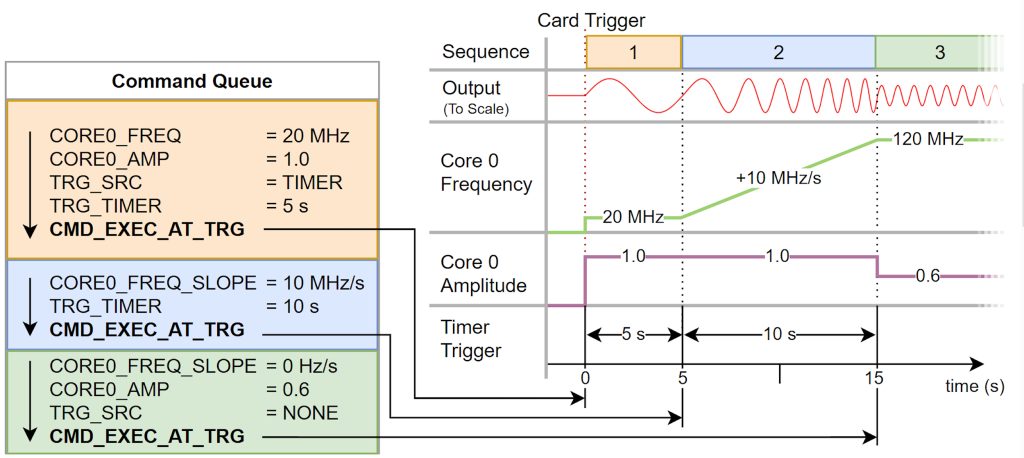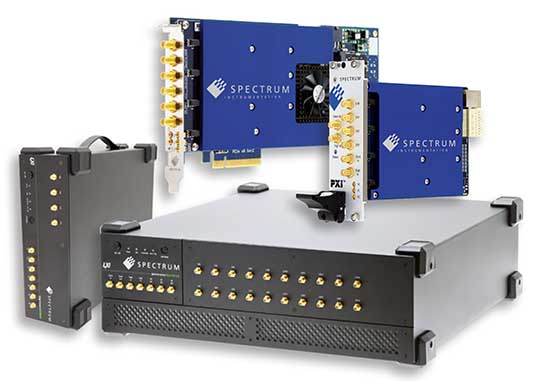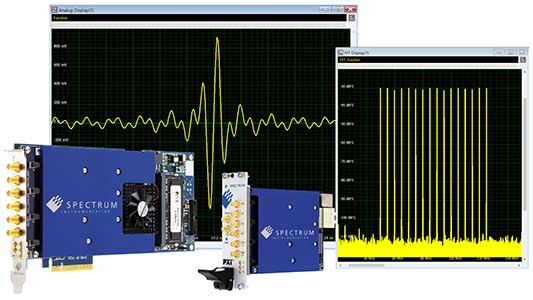Bangalore, India – Spectrum Instrumentation has released a new firmware option for its range of versatile 16-bit Arbitrary Waveform Generators (AWGs) with sampling rates up to 1.25 GS/s and bandwidths up to 400 MHz. The new option allows users to define 23 DDS cores per AWG-card, that can be routed to the hardware output channels. Each DDS core (sine wave) can be programmed for frequency, amplitude, phase, frequency slope and amplitude slope. This enables, for example, the control of lasers through AODs and AOMs, as often used in quantum experiments, with just a few simple commands – instead of making large data array calculations. The DDS output can be synchronized with external trigger events or by a programmable timer with resolution of 6.4 ns.
Link to the product video (5 min):
DDS-example with 16 superimposed sine waves on one AWG output channel and the FFT analysis DDS – Direct Digital Synthesis – is a method for generating arbitrary periodic sine waves from a single, fixed-frequency reference clock. It is a technique widely used in a variety of signal generation applications. The DDS functionality implemented on Spectrum Instrumentation’s AWGs is based on the principle of adding multiple ‘DDS cores’ to generate a multi-carrier (multi-tone) signal with each carrier having its own well-defined frequency, amplitude and phase.
Advantages of using DDS for arbitrary waveform generators
With the ability to switch between the normal AWG mode (which generates waveforms out of pre-programmed data) and the DDS mode (which needs only a few commands to generate sine wave carriers), the Spectrum AWGs are highly versatile and can be adapted to almost any application. In DDS-mode, the AWG acts as a base for the multi-tone DDS. The units built-in 4 GByte of memory and fast DMA transfer mode then allows the streaming of DDS commands at a rate as high as 10 million commands per second! This unique capability provides the flexibility to perform user-defined slopes (e.g. s-shaped) as well as various modulation types (e.g. FM and AM) with simple, easy-to-use, DDS commands.
DDS in Quantum Experiments

For years now, Spectrum AWGs have been successfully used worldwide in pioneering quantum research experiments. Since 2021, Spectrum Instrumentation has been part of the BMBF (German federal ministry of education and research) funding program ‘quantum technologies – from basic research to market’ as part of the Rymax One consortium. The aim of this consortium is building a Quantum Optimizer. The development of the DDS option was based on feedback from the consortium partners and other research institutes worldwide.
The flexibility and fast streaming-mode of Spectrum’s AWGs, which also enables data to be streamed straight from a GPU, allows the control of Qubits directly from a PC. While using an AWG in this way offers full control of the generated waveforms, the drawback is that huge amounts of data need to be calculated. This slows the critical decision-making loop. In contrast, using the versatile multi-tone DDS functionality greatly reduces the amount of data that must be transferred, while still keeping full control. All the key functionality required for quantum research is built in. With just a single command users can apply intrinsic dynamic linear slope functions to produce extremely smooth changes to frequency and amplitude.
DDS controls waveforms in Test, Measurement and Communications
In many kinds of testing systems, it is important to produce and readily control accurate waveforms. The DDS option provides an easy and programmable way for users to produce trains of waveforms, frequency sweeps or finely tuneable references of various frequencies and profiles. Applications that require the fast frequency switching and fine frequency tuning that DDS offers are widespread. They can be found in industrial, medical, and imaging systems, network analysis or even communication technology, where data is encoded using phase and frequency modulation on a carrier.
Availability of DDS option

The DDS option is available now for the full range of M4i.66xx PCIe cards, M4x.66xx PXIe modules, portable LXI/Ethernet DN2.66x units and multi-channel desktop LXI/Ethernet DN6.66xx products. By simply performing a firmware update, all previously purchased 66xx series products can be equipped with the new firmware option. Programming can be done using the existing driver SDKs that are included in the delivery. Examples are available for Python, C++, MATLAB, LabVIEW and many more. The option is available now.













